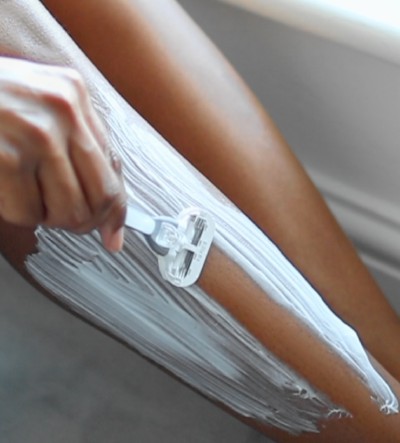Want a super close, super smooth, longer-lasting shave? This moisturising shaving cream softens hair, protects skin and effortlessly glides the razor for one swipe perfection!
No more multiple passes, missed patches, and irritated skin - try this shaving cream for the smoothest of shaves! Oh and this shaving cream goes both ways, so make sure you make enough to share - I don’t want to get blamed for any arguments!
Recipe
Water Phase
- 152g Water
- 4g Glycerine
- 12g Decyl Glucoside
Oil Phase
- 12g Jojoba Oil
- 10g BTMS-25 (See below for substitution)
- 10g Stearic Acid (See below for substitution)
Cool Down
- 2g Preservative Eco
- 2g Essential Oils (Optional)
Method
- Measure out the Water Phase ingredients: Water, Glycerine and Decyl Glucoside and the Oil Phase ingredients: BTMS, Jojoba Oil and Steric Alcohol
- Gently melt both phases in separate heat proof containers over a low heat using a double boiler or bain marie
- Once the oil and water phases have completely melted, mix together and transfer to a flat surface
- To create a light and airy emulsion, use an immersion blender or whisk. As the mixture cools and more air is incorporated, it will start to thicken and change to a pale cream colour
- When you are happy with the consistency, you can move on to adding the preservative and essential oils
- Use a scale to add the Cool Down ingredients: preservatives and essential oils of choice
- Give a short, quick mix either by hand or using a blender just to ensure all the ingredients are evenly distributed
- Store Shaving Cream in an airless pump bottle. This will help to prolong its shelf life
This recipe makes 200g. See the interactive shaving cream formula to customise this recipe and amount.

How shaving creams work
Shaving creams, gels, soaps & foams might appear different but they all serve the same function - to aid in a smooth, clean shave. There are 4 key elements that make them so effective. The combined effects result in a shaving cream that simultaneously protects and allows the razor to effortlessly glide over the skin, producing an extra close, silky-smooth shave.
- Water - hydrates & softens the skin keeping it flexible, and also works as a solvent to activate the rest of the ingredients. Water is an essential component, this is why shaving soaps need to be mixed with water into a lather first in order to be effective.
- Humectants - attract moisture to the surface of your skin providing a constant stream of hydration throughout the shaving process

- Surfactants - provide lather that acts as a cushion to protect your skin during shaving. Surfactants produce “foam” due to having both oil and water-loving properties, this reduces the contact between your skin and the razor.
- Emollients - lubricate, condition and soften the hair making it easier to remove. They’re essential, particularly for areas of dense, coarse hair that might otherwise catch the razor.


Why Use BTMS?

How does BTMS work in shaving creams?
It’s common for homemade or DIY shaving cream recipes to focus on moisturising and foaming elements but not conditioning - which can lead to them not being as effective as their store-bought counterparts. The same reason why many prefer to shave with hair conditioners over soaps, is also why this one ingredient creates the best shaving experience.
Areas with coarse or thick hair are likely to catch, snag or tangle within the razor as you shave. This can make shaving more difficult and often result in going over the same area repeatedly to produce a smooth shave (generally something you want to avoid as it can lead to skin irritation). Conditioning the hair makes the follicle softer, more flexible and easier to cut, allowing you to shave more effectively and reduce the chance of skin irritation.
No BTMS? No Problem!
Although I strongly recommend BTMS, especially if you have afro hair or plan on making conditioning cosmetics - I understand that we don’t have unlimited space or budget for specialist products! You can supplement the BTMS in this recipe for regular emulsifying wax and fatty alcohol. Please note, while this will still make a great shaving cream, it won’t have the same conditioning elements that make it as effective on coarse hair or sensitive skin.
Substitutions
For BTMS:
- 8g Emulsifying Wax
- 2g Cetyl Alcohol or Cetearyl Alcohol
For Stearic Acid
- 10g Cetyl or Cetearyl Alcohol
Please note: the alternatives here make use of ingredients that I commonly use in my tutorials rather than a like-for-like substitution. They won’t produce the same texture, but they can still be used to make an effective shaving cream.


Can this shaving cream be used on sensitive skin?

Jojoba oil benefits for sensitive skin
Due to jojoba oil’s resemblance to our skin’s natural sebum, it’s a great choice to use in products for sensitive or irritable skin. It’s able to dissolve effortlessly into both the skin and hair without triggering irritation, actually soothing skin throughout and after the shaving process. Shaving exfoliates the outer layer of the epidermis and, though unlikely, can cause small micro-abrasions to the skin. If you regularly experience sensitivity or itchiness, jojoba’s natural antimicrobial and antifungal properties can provide relief to inflamed skin, limiting any further damage.
It is also recommended that we do a patch test first to ensure that we are not sensitive or have a reaction to any of the ingredients in topical products before applying.
So whether we’re a shaving cream, soap, conditioner or foam fanatic, this shaving cream can do it all!
